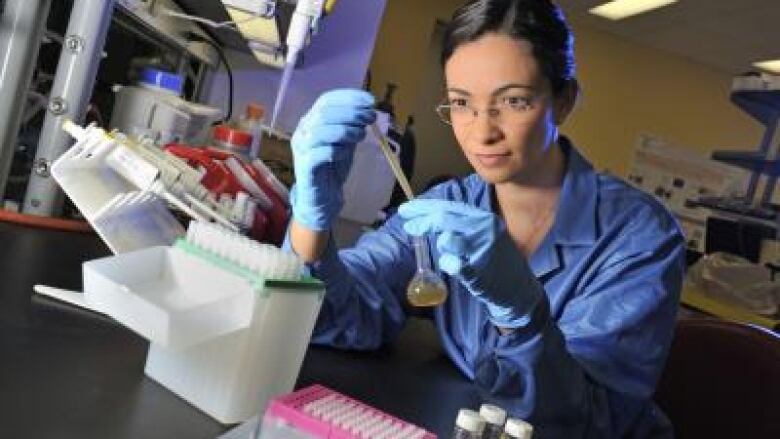Silver nanoparticle use spurs U.S. consumer database
Database tracks growing number of consumer goods containing nanomaterials

The antibacterial superpowers of silvernanoparticleshave landed them in household products ranging from self-sanitizing toothbrushes and washing machines tomold- and bacteria-resistant stuffed toys and underwear.
These microscopic particles have become ubiquitous, but some are also questioning their risks. As a result, aU.S. research group has launched a public database to help people identify products containing silver and other nanoparticles.
Many manufacturers have touted the antibacterial benefits of these microscopic pieces of silver, but the potential health and environmental risks are lesser known.
We dont really understand very well what can happen to people when they get exposed to high doses of silver nanoparticles, said Nina Quadros, associate director of the Virginia Tech Center for Sustainable Nanotechnology.
If you inhale silver nanoparticles, theyre definitely bad for you.- NinaQuadros, Virginia TechCenterfor Sustainable Nanotechnology
Material such as silver nanoparticlescan have big benefits for hygiene.Quadrossaid the basis of their antibacterial power is that they destroy the DNA and enzymes inside bacteria, causing the bacteria to die.
Eachnanoparticleis about 1/1000ththe diameter of a human hair, and it is able to kill both common and drug-resistant microbes.
The only thing that [distinguishes] a silvernanoparticlefrom a silver spoon or a silver earring is the fact that it is so, so very small, saidQuadros.
People have used fine particles of silver and other metals since the16thcentury for applications such as dyeing stained glass windows or keeping cows milk fresh. But it wasnt until 1974 that a scientist in Tokyo first used the term nanotechnology, according to DiscoverNano.org.
In the last 10 years, scientists have taken on the challenge of creating a database onnanomaterialsthat provides a resource for consumers on the link between specific products and the scientific studies in which they are tested.
On Oct. 28, the WilsonCenter, an independent research centre in Washington D.C., released the most comprehensive database of consumer products that self-identify as containingnanomaterials. This inventory currently includes 1,628 consumer products from around the world.
Silver is the most common material in the database, with 383 products listed. Titanium is the second most common, with 179 products listed.
The Nanotechnology Consumer Products Inventory was assembled by scientists working with the WilsonCenter, in part to facilitate more informed public policy debates, according to its website.
Quadros, who works with the WilsonCenter, said that before this database was put online in 2007, citizens, researchers and policymakers didnt have a source to check how, and in what consumer products,nanoparticlesare used.
Household products containing silvernanoparticlesinclude such items as toothpaste, face creams, medical bandages, disinfectants, kids' plush toys, baby blankets, towels, socks, kitchen utensils and insecticides.
Examining the benefits and risks
This database compiles the known benefits and risks of nanotechnology from the point of view both of manufacturers ofnano-techproducts and the scientists studying them.
For example, the database contains wording from the makers of the Benny the Bear plush toy, which states,With the additive of silvernanoparticles, our product has been clinically proven to fight against harmful bacteria,moldsand mites.
On the same web page, youll find an excerpt from a research paper that assessed the risks posed by such goods for children: levels of silver to which children may potentially be exposed during the normal use of these consumer products is predicted to be low.
While the human health risks of using silver nanoparticles are not well understood, if you inhale silver nanoparticles, theyre definitely bad for you, said Quadros.
In a 2011 study published in the journal Environmental Science and Technology,Quadrosfound silvernanoparticlesin throat sprays that can accumulate over time and cause lung damage.
Silver is a metal, and it bio-accumulates, saidQuadros. Your body will release some of the silver, but a lot of it gets deposited on your skin and it can get deposited in many different organs.
As for environmental risks, silvernanoparticlesin waste water runoff can potentially upset the balance of the food web. TheCenterfor Environmental Implications of Nanotechnology website highlights an experiment in which silvernanoparticlesin waste water runoff killed a third of the plants and microbes exposed to the liquid.
ToddKuiken, senior research associate at the WilsonCentersScience and Technology Innovation Program (STIP), said the new database will help consumers make up their own mind on the safety or efficiency of a product.
The WilsonCenterintends to usecrowdsourcingto keep the database current and accurate.
We hope scientists, policymakers and citizens will contribute new information to the inventory, said DavidRejeski, director of the WilsonCentersSTIP.
Broad participation, especially from the scientific community, will help make the inventory more accurate and usable over time."












_(720p).jpg)


 OFFICIAL HD MUSIC VIDEO.jpg)
.jpg)



























































































